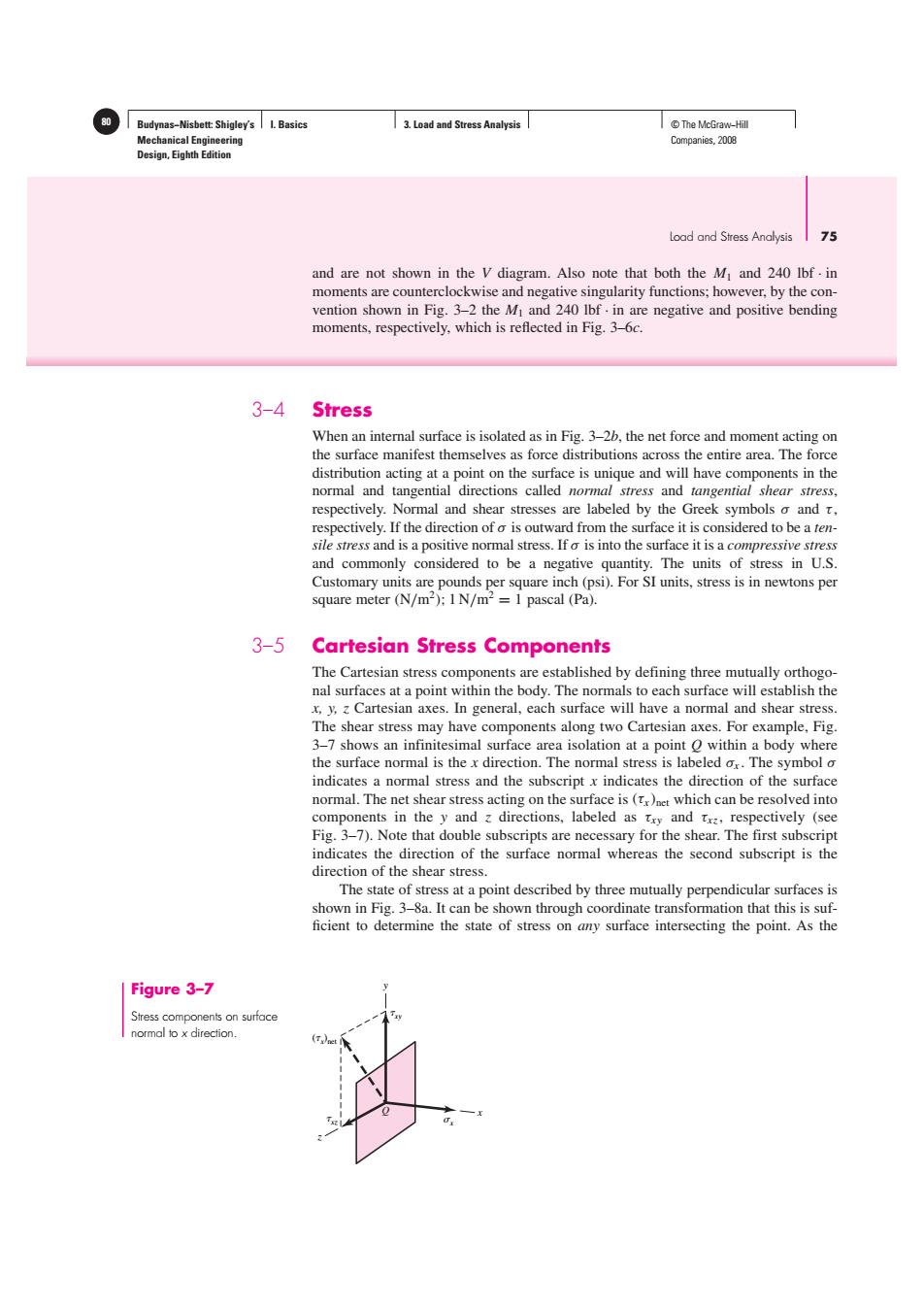正在加载图片...

80 Budynas-Nisbett:Shigley's I.Basics 3.Load and Stress Analysis ©The McGraw-Hil Mechanical Engineering Companies,2008 Design,Eighth Edition Load and Stress Analysis 75 and are not shown in the V diagram.Also note that both the M and 240 Ibf.in moments are counterclockwise and negative singularity functions;however,by the con- vention shown in Fig.3-2 the M and 240 lbf.in are negative and positive bending moments,respectively,which is reflected in Fig.3-6c. 3-4 Stress When an internal surface is isolated as in Fig.3-2b,the net force and moment acting on the surface manifest themselves as force distributions across the entire area.The force distribution acting at a point on the surface is unique and will have components in the normal and tangential directions called normal stress and tangential shear stress, respectively.Normal and shear stresses are labeled by the Greek symbols o and t, respectively.If the direction of o is outward from the surface it is considered to be a ten- sile stress and is a positive normal stress.If o is into the surface it is a compressive stress and commonly considered to be a negative quantity.The units of stress in U.S. Customary units are pounds per square inch(psi).For SI units,stress is in newtons per square meter (N/m);I N/m=1 pascal (Pa). 3-5 Cartesian Stress Components The Cartesian stress components are established by defining three mutually orthogo- nal surfaces at a point within the body.The normals to each surface will establish the x,y,z Cartesian axes.In general,each surface will have a normal and shear stress. The shear stress may have components along two Cartesian axes.For example,Fig. 3-7 shows an infinitesimal surface area isolation at a point O within a body where the surface normal is the x direction.The normal stress is labeled or.The symbol o indicates a normal stress and the subscript x indicates the direction of the surface normal.The net shear stress acting on the surface is(x)oet which can be resolved into components in the y and z directions,labeled as ty and Tx,respectively (see Fig.3-7).Note that double subscripts are necessary for the shear.The first subscript indicates the direction of the surface normal whereas the second subscript is the direction of the shear stress. The state of stress at a point described by three mutually perpendicular surfaces is shown in Fig.3-8a.It can be shown through coordinate transformation that this is suf- ficient to determine the state of stress on any surface intersecting the point.As the Figure 3-7 Stress components on surface normal to x direction.Budynas−Nisbett: Shigley’s Mechanical Engineering Design, Eighth Edition I. Basics 3. Load and Stress Analysis 80 © The McGraw−Hill Companies, 2008 Figure 3–7 Stress components on surface normal to x direction. Load and Stress Analysis 75 and are not shown in the V diagram. Also note that both the M1 and 240 lbf · in moments are counterclockwise and negative singularity functions; however, by the convention shown in Fig. 3–2 the M1 and 240 lbf · in are negative and positive bending moments, respectively, which is reflected in Fig. 3–6c. 3–4 Stress When an internal surface is isolated as in Fig. 3–2b, the net force and moment acting on the surface manifest themselves as force distributions across the entire area. The force distribution acting at a point on the surface is unique and will have components in the normal and tangential directions called normal stress and tangential shear stress, respectively. Normal and shear stresses are labeled by the Greek symbols σ and τ , respectively. If the direction of σ is outward from the surface it is considered to be a tensile stress and is a positive normal stress. If σ is into the surface it is a compressive stress and commonly considered to be a negative quantity. The units of stress in U.S. Customary units are pounds per square inch (psi). For SI units, stress is in newtons per square meter (N/m2 ); 1 N/m2 = 1 pascal (Pa). 3–5 Cartesian Stress Components The Cartesian stress components are established by defining three mutually orthogonal surfaces at a point within the body. The normals to each surface will establish the x, y, z Cartesian axes. In general, each surface will have a normal and shear stress. The shear stress may have components along two Cartesian axes. For example, Fig. 3–7 shows an infinitesimal surface area isolation at a point Q within a body where the surface normal is the x direction. The normal stress is labeled σx . The symbol σ indicates a normal stress and the subscript x indicates the direction of the surface normal. The net shear stress acting on the surface is (τx )net which can be resolved into components in the y and z directions, labeled as τxy and τxz, respectively (see Fig. 3–7). Note that double subscripts are necessary for the shear. The first subscript indicates the direction of the surface normal whereas the second subscript is the direction of the shear stress. The state of stress at a point described by three mutually perpendicular surfaces is shown in Fig. 3–8a. It can be shown through coordinate transformation that this is suf- ficient to determine the state of stress on any surface intersecting the point. As the Q y x z x xy xz (x)net